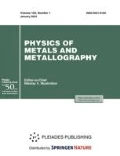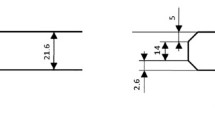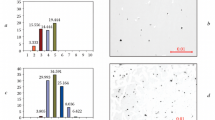Abstract
The weld joints of pipes with a diameter of 1420 mm and a pipe-wall thickness of 30 mm manufactured by two different technologies have been studied. These technologies were (i) combining the laser arc welding when making a root weld with the subsequent submerged arc welding when applying cap welds and (ii) the method of double-sided submerged arc welding. It has been shown that the first technology leads to the formation of a bainite-based disperse structure in weld joints, thereby providing a tough-ductile character of fracture and an increased level of impact strength for different positions of a notch with respect to the center of a weld joint.






Similar content being viewed by others
REFERENCES
L. I. Efron, Metal Science in “Large” Metallurgy. Pipe Steels (Metallurgizdat, Moscow, 2012) [in Russian].
C. Liu and S. D. Bhole, “Challenges and developments in pipeline weldability and mechanical properties,” Sci. Technol. Weld. Joining 18, No. 2, 169–181 (2013).
E. Shigeru and N. Naoki, “Development of thermo-mechanical control process (TMCP) and high performance steel in JFE,” JFE Tech. Rep., No. 20, 1–7 (2015).
A. N. Bortsov, I. P. Shabalov, A. A. Velichko, K. Yu. Mentyukov, and I. Yu. Utkin, “Features of multi-electrode submerged arc welding in the production of high-strength thick-walled pipes,” Metallurg, No. 4, 69–76 (2013).
L. A. Efimenko, T. S. Esiev, D. V. Ponomarenko, S. P. Sevast’yanov, and I. Yu. Utkin, “Effect of heat treatment on the impact strength of the metal of welded joints of pipes made by multi-arc submerged arc welding,” Metallurg, No. 3, 59–63 (2018).
C. Churiaque, M. Chludzinski, M. Porrua-Lara, A. Dominguez-Abecia, F. Abad-Fraga, and J. M. Sánchez-Amaya, “Laser hybrid butt welding of large thickness naval steel,” Metals. 9, No. 1, 100 (2019). https://doi.org/10.3390/met9010100
B. Acherjee, “Hybrid laser arc welding: State-of-art review,” Opt. Laser Technol. 99, 60–71 (2018).
The Theory of Laser Materials Processing. Heat and Mass Transfer in Modern Technology, Ed. by J. Dowden (Springer, Berlin, 2009).
A. P. Romantsov, M. A. Fedorov, A. A. Chernyaev, and A. O. Kotlov, RF Patent No. 2640105 (2017).
S. E. Gook, A. V. Gumenyuk, and M. Retmaier, “Hybrid laser-arc welding of high-strength API X80 and X120 pipe steels,” Global’naya Yadernaya Bezopasnost’, No. 1, 21–35 (2017).
J. Górka, “Structure and properties of hybrid laser arc welded-joints (laser beam – mag) in thermo-mechanical control processed steel S700mc of 10 mm thickness,” Arch. Metall. Mater. 63, No. 3, 1125–1131 (2018).
I. Yu. Utkin, L. A. Efimenko, V. Yu. Bobrinskaya, and O. E. Kapustin, “Evaluation of the role of vanadium and molybdenum in changing the kinetics of austenite decomposition and the mechanical properties of the simulated overheating zone of low-carbon niobium steels,” Phys. Met. Metallogr. 122, No. 7, 718–724 (2018).
L. A. Efimenko, O. E. Kapustin, D. A. Ponomarenko, I. Yu. Utkin, M. A. Fedorov, and A. I. Romantsev, “Features of the formation of the structure and properties of welded joints in laser-hybrid welding of longitudinal pipe joints,” Metallurg, No. 11, 63–68 (2020).
GOST ISO 3183–2015. Steel Pipes for Pipelines of the Oil and Gas Industry.
STO Gazprom 2-4.1-713-2013. Technical Requirements for Pipes and Fittings.
GOST 6996–66. Methods for Determination of Mechanical Properties.
Y. Kimura, T. Inoue, F. Yin, and K. Tsuzaki, “Inverse temperature dependence of toughness in an ultrafine grain-structure steel,” Science 320, No. 5879, 1057–1060 (2008).
A. S. Dolzhenko, P. D. Dolzhenko, A. N. Belyakov and R. O. Kaibyshev, “Microstructure and impact toughness of high-strength low-alloy steel after tempforming,” Phys. Met. Metallogr. 122, No. 10, 1014–1022 (2021).
I. L. Yakovleva, N. A. Tereshchenko, D. A. Mirzaev, A. V. Panov, and D. V. Shaburov, “Impact toughness and plastic properties of composite layered samples as compared to monolithic ones,” Phys. Met. Metallogr. 104, No. 2, 203–211 (2007).
Funding
This study was performed within the state task from the Ministry of Science and Higher Education of Russia (project “Structure” no. AAAA-A18-118020190116-6).
Author information
Authors and Affiliations
Corresponding author
Additional information
Translated by E. Glushachenkova
Rights and permissions
About this article
Cite this article
Tereshchenko, N.A., Yakovleva, I.L., Fedorov, M.A. et al. Structure and Impact Strength of Weld Joints Manufactured from a Pipe Steel with the Use of Hybrid Laser-Arc Welding. Phys. Metals Metallogr. 123, 535–541 (2022). https://doi.org/10.1134/S0031918X22050167
Received:
Revised:
Accepted:
Published:
Issue Date:
DOI: https://doi.org/10.1134/S0031918X22050167




